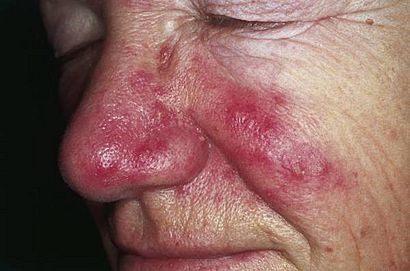Rosacea facts for kids
Quick facts for kids Rosacea |
|
|---|---|
| Synonyms | Acne rosacea |
 |
|
| Rosacea over the cheeks and nose | |
| Symptoms | Facial redness, pimples, swelling, and small and superficial dilated blood vessels |
| Complications | Rhinophyma |
| Usual onset | 30–50 years old |
| Duration | Long term |
| Types | Erythematotelengiectatic, papulopustular, phymatous, ocular |
| Causes | Unknown |
| Risk factors | Family history |
| Diagnostic method | Based on symptoms |
| Similar conditions | Acne, perioral dermatitis, seborrhoeic dermatitis, dermatomyositis, lupus |
| Medication | Antibiotics either by mouth or applied to the skin |
| Frequency | ~5% |
Rosacea is a chronic facial condition that is characterized through acne and redness. It can happen to people of any age. It gets worse if left untreated. There are four types of rosacea, three involving human skin and the fourth affecting eyes.
Rosacea affects mostly Caucasians, though some other races can be affected. Rosacea affects both males and females. Females are three times more likely than males to get rosacea. Things that can cause rosacea are exposure of the face to extreme temperature, the heat of sunlight, severe sunburn, stress, anxiety, alcohol and spicy foods. Most people with rosacea have only mild redness and are never officially diagnosed or treated.
Images for kids
-
Micrograph showing rosacea as enlarged, dilated capillaries and venules located in the upper dermis, angulated telangiectasias, perivascular and perifollicular lymphocytic infiltration, and superficial dermal edema.
See also
 In Spanish: Rosácea (enfermedad) para niños
In Spanish: Rosácea (enfermedad) para niños



